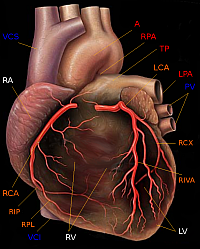George Washington University in Washington, D.C., and venture capital company Allied Minds Inc. in Boston, formed LuxCath LLC, a new company that makes a device for increasing the speed and safety of surgery for irregular heartbeat. LuxCath’s technology is based on research by faculty at George Washington’s medical school and engineering department.
LuxCath is developing a device to better visualize the tissue and lesions affected by radio frequency catheter ablation, a relatively new procedure to treat atrial fibrillation, the most common type of arrhythmia or irregular heartbeat. Atrial fibrillation occurs when jumbled electrical signals to the top part of the heart contract very fast and irregularly. People with atrial fibrillation often do not experience symptoms, but if left untreated, the condition can lead to stroke or heart failure.
With radio frequency catheter ablation, a surgeon inserts a thin wire through a catheter in the patient’s groin, up to the heart, where the wire emits a radio signal that creates heat. The radio-generated heat destroys the tissue causing the jumbled electrical signals, thus enabling a more regular heartbeat to resume.
While radio frequency catheter ablation is a minimally-invasive procedure, it requires precise targeting to address the problematic heart tissue. Research by George Washington medical faculty Marco Mercader and Narine Sarvazyan, and biomedical engineer Matthew Kay led to development of a device to better visualize the targeted lesions and surrounding tissue to make sure the procedure squarely hits the target.
The device uses a method of illuminating tissue by fluorescence with a compound called beta-nicotinamide adenine dinucleotide or NADH that binds with tissue cells and can be visualized almost instantly with harmless infrared rays. The research by Mercader, Sarvazyan, and Kay shows the fluorescence of NADH stored in tissue cells aids the visualization of injured outer heart muscle tissue addressed by radio frequency catheter ablation.
“We formed LuxCath to ensure that electrophysiologists are treating the right parts of the heart in atrial fibrillation patients quickly and effectively,” says Omar Amirana, Allied Minds’ life sciences director. “LuxCath’s technology should significantly improve procedural outcomes for patients, speed up procedures, as well as minimize costly and burdensome follow-up re-treatments.”
Read more:
- Medical Monitor Device Start-Up Raises $7M in Venture Funds
- Technology Developed to Diagnose, Treat Atrial Fibrillation
- Alcohol Consumption Indicated as Atrial Fibrillation Cause
- NIH Trials to Assess Emergency Cardiac Arrest Treatments
- Researchers Develop Low-Energy Cardiac Defibrillation
* * *


 RSS - Posts
RSS - Posts
You must be logged in to post a comment.